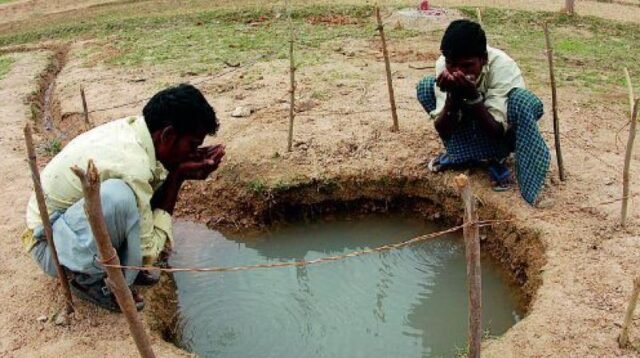Hyderabad: Telangana received 21 per cent more rainfall than normal during the water year 2024-25, up to March 31, 2025, but groundwater levels across the state have shown a mixed trend.
According to the ground water department, which monitors groundwater at 1,771 locations across 33 districts, the average depth at which groundwater was available was 9.91 metres below ground level (mbgl). While there is a slight improvement of 0.45 metre compared to last summer (May 2024), it also marked a 0.22-metre decline from the same time last year (March 2024).
Across the state, 14 districts showed improvement in groundwater levels. Nalgonda saw the highest rise of 3.18 metres, followed by Nagarkurnool (+2.27 m), Jogulamba-Gadwal (+2.22 m) and Suryapet (+2.19 m). However, 19 districts, including Bhupalpally which recorded the sharpest drop of 6.44 metres saw a decline.
Over the past decade, the area with very deep water levels (more than 20 metres) has more than doubled, from 1,547 square kilometres to 3,212 square kilometres across the state.
Borewell diggers and residents explain that groundwater availability and depth vary greatly by location and elevation. In areas located at a higher elevation like Gachibowli, Hitec City, Madhapur and Kondapur, water is often found only after digging more than 50 feet.
“The depth of borewells really depends on the area,” said Shiva Prakash, a borewell technician. “In higher elevation places, you usually have to go much deeper. In flat areas, you might get water at 30 feet, but that doesn’t mean it’s reliable.”
He explained that even when water is found at shallow depths, people often choose to dig deeper. “That’s because water at 30 or 50 feet doesn’t last long. It dries up fast, especially in summer. Most borewells now go 200 to 300 feet deep, so they can survive seasonal drops.”
Adding to this, Satyanarayana, a senior official from the water board explained the science behind it.
“Water underground doesn’t stay fixed at one particular depth. It moves and adjusts based on natural forces. One of the major reasons for this is something called hydrostatic pressure, that’s the pressure exerted by the weight of water in the surrounding rock layers.”
“When a borewell is drilled and hits a water-bearing zone, the pressure in that layer can actually push the water upward inside the borehole. This is why, even if the water source is at, say 200 feet, the water level in the borewell might stabilise at 100 feet, it’s trying to balance with atmospheric pressure at the surface.”
He explained that people could not rely only on that visible water level. “It’s not always stable. Groundwater levels change with the seasons, they rise after rains and fall during the summer, sometimes rapidly. If the source of water is shallow, it can dry up quickly. That’s why most people now drill deeper.”
D. Nagaraj, a long-time resident of Secunderabad, said, “A few decades ago, we used to strike water at 30 or 50 feet. Now, no one stops before 100 feet. We have overused groundwater over the years and it’s no longer available like before.”
In gated communities too, borewells are going deeper. A resident from Sainikpuri said, “We hit water at around 100 feet, but dug till 300 feet. In summer, the water table drops. With so many people living here, we had to plan ahead.”
V. Goutham from Boduppal added, “The ground has different layers. The first water-bearing layer, around 100 feet deep, doesn’t last. The more reliable second layer is much deeper, between 200 to 300 feet, that is why we dig deeper.”
As the water table continues to fall and borewells go deeper, Water Board officials noted the importance of rainwater harvesting. To avoid such problems, we are asking people to install rainwater harvesting pits, but many people still haven’t implemented it.








